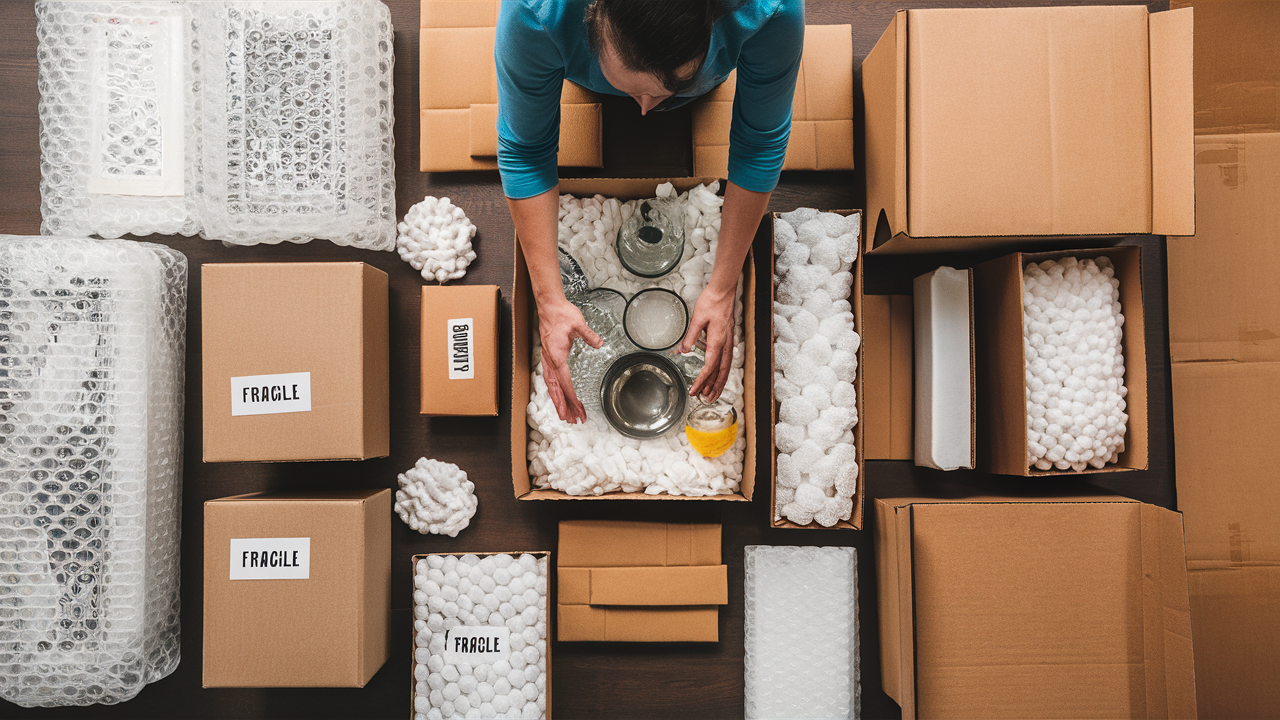When you're packing and organizing fragile items, start with high-quality boxes and materials like bubble wrap and packing paper. Wrap each piece individually to absorb shocks, and fill empty spaces with packing peanuts for stability. Make sure to label your boxes clearly, noting their contents and fragile status. Group similar items together, and create an inventory list for easier tracking. Handle boxes gently, using gloves to avoid damaging surfaces. If you're unsure, hiring professional movers can really help, as they have the right equipment and expertise. You'll find even more helpful tips as you explore further.
Essential Packing Materials
When packing fragile items, choosing the right materials is crucial for ensuring their safety during transit. Start with high-quality corrugated cardboard boxes, as they provide the durability needed to protect your delicate belongings.
It's also important to use a variety of packing boxes in different sizes to accommodate all item shapes and weights, as noted in essential packing materials.
Next, use bubble wrap to wrap each fragile item. This material offers essential cushioning, absorbing shocks and preventing damage.
Don't forget about soft packing paper, which can be used to wrap objects tightly, preventing scratches and adding another layer of protection.
To fill any empty spaces in your boxes, consider packing peanuts. They effectively minimize movement, helping to keep your fragile items secure. This added stability is vital in preventing breakage during transport.
Effective Wrapping Techniques
Effective wrapping techniques are essential for safeguarding your fragile items during transit. When packing, you want to ensure that each piece is well-protected from potential damage. Specialty movers are experienced in handling delicate items, providing specialized packing solutions tailored to your needs.
Here are some effective strategies to consider:
- Wrap each fragile item individually using bubble wrap and secure it with packing tape to create a protective cushion against shocks and impacts.
- For glassware and ceramics, place them vertically in boxes, using crumpled packing paper between items to minimize surface contact and prevent chipping.
- When packing artwork and mirrors, protect corners with cardboard and wrap the entire piece in bubble wrap to guard against scratches and breaks.
- For electronics, remove detachable components, wrap them in anti-static materials, and place them in their original boxes if available for maximum protection.
It's also important to fill any empty spaces in the boxes with additional packing materials, such as crumpled paper or packing peanuts. This helps restrict movement and enhances stability during transit.
Organizing and Labeling Boxes
Organizing and labeling boxes is crucial for a smooth moving experience. Proper packing of fragile items requires extra care to prevent breakage during transit; thus, consider moving preparation and planning as part of your strategy. You should clearly label each box with its contents and indicate if it contains fragile items to ensure careful handling during transport.
Use bold, permanent markers for visibility, and write on multiple sides of the box for easy identification from different angles.
Incorporating color-coded labels for different categories, such as kitchenware or decor, can streamline unpacking at your new place. This way, you can quickly identify where everything belongs.
It's also important to group similar items together, which not only aids during packing but simplifies the unpacking process.
Creating an inventory list of fragile items alongside labeled boxes helps you track your valuable possessions and ensures nothing gets overlooked during the move.
When you maintain an organized system, unpacking becomes less overwhelming, allowing you to settle into your new space more easily.
Handling and Transport Precautions
Handling fragile items during a move requires careful attention to detail to prevent breakage. When packing fragile items, you must prioritize safety and organization.
Here are some essential transport precautions to keep in mind:
- Lift with care: Always lift boxes containing fragile items gently. Consider using a dolly to avoid dropping delicate belongings during transport.
- Wear gloves: Using gloves while handling items helps prevent transferring oils from your skin that could damage surfaces.
- Avoid stacking: Never place the heaviest items on top of boxes clearly labeled "Fragile." This minimizes the risk of crushing and damaging contents.
- Maintain a steady pace: Move your fragile items at a controlled speed to prevent sudden movements that could lead to breakage.
Seeking Professional Help
When you're dealing with fragile items, seeking professional help can make all the difference in ensuring their safety during a move. Hiring professional movers trained in the best packing techniques significantly reduces the risk of damage to your delicate belongings.
These experienced movers know how to handle fragile items and use high-quality packing paper and bubble wrap to protect them.
Many moving companies, like Safebound Moving & Storage, offer packing services that include custom packing solutions tailored to your specific needs. This means your valuable items are packed securely, minimizing the chances of breakage.
Additionally, professionals often have access to specialized equipment, such as dollies and packing tools, which aid in the safe transport of your fragile possessions.
Utilizing packing services not only saves you time and effort but also allows you to focus on other aspects of your move.
Many companies provide insurance options that cover damages to fragile items during transit, giving you peace of mind.
Conclusion
In summary, packing and organizing fragile items is crucial for their safety during transport. By using the right materials, effective wrapping techniques, and clear labeling, you can protect your belongings. Always handle boxes with care and consider seeking professional help if needed. With these tips in mind, you can ensure that your fragile items arrive at their destination intact. Remember, a little extra effort in packing goes a long way in preventing damage.
